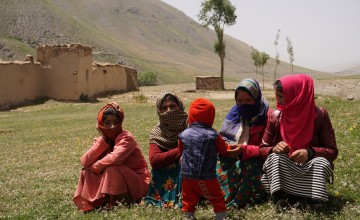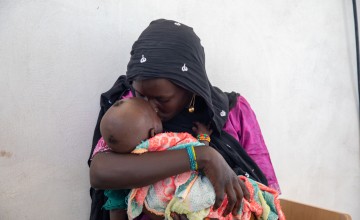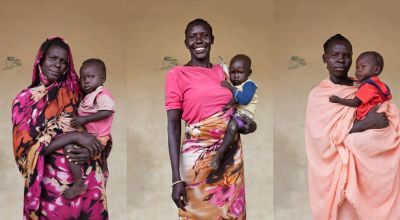
Read our 2024 annual report

Knowledge Hub
First, the good news: Even with a significant spike in 2021, the global maternal mortality ratio (MMR) has gone down by more than 57% in the last 40 years.
Where in 1985 we saw an average of 460 deaths per every 100,000 live births, the latest figures, published in 2023, indicate that the global average is now at 197.
The numbers may seem complicated, but the MMR is how the World Health Organisation is able to compare maternal mortality rates from country to country, ranking them as relative to the number of live births in each country to account for the fact that birth rates vary greatly around the world.
Despite the progress, however, there are still many countries with maternal mortality rates that well exceed the average. Using the latest WHO data, these are the 10 “worst” countries to be a mother — at least in terms of how fatal pregnancy and birth can be.
10. Guinea
WHO places the West African nation of Guinea’s maternal mortality rate at 494 deaths per 100,000 live births. While the number is high, it’s a significant improvement over the last 25 years (in 2000, it was recorded at 971 deaths per 100,000 live births, meaning that it’s dropped by nearly half).
9. Guinea-Bissau
Just northwest of Guinea, Guinea-Bissau is also close in Maternal Mortality Ratio: 505 deaths to 100,000 live births. This is also an improvement: Ten years ago, UNICEF recorded the country’s MMR at 900 deaths to 100,000 live births. Like many countries on this list, one of the issues for Bissau-Guinean mothers-to-be is that rural communities are underdeveloped and underserved when it comes to quality health care. As UNFPA noted in 2021, “health centres have nurses and midwives but no obstetrician/gynaecologists to immediately assess high-risk obstetric cases.”
8. Benin
While both Guinea and Guinea-Bissau have made improvements in their MMRs, Benin has lost progress, rising from 397 deaths per 100,000 live births in 2020 to 518 in 2023.

7. Afghanistan
When we first published this list in 2022, Afghanistan’s maternal mortality rate was recorded as 638 deaths per 100,000 live births (a figure last updated in 2017). The most recent data shows some improvement, with the rate dropping by nearly 20% to 521. However, there are still challenges: According to UNFPA, fewer than 60% of births in Afghanistan are overseen by skilled healthcare professionals. Finances and harmful gender norms are often a double-hindrance to women seeking professional help, especially in rural areas.
6. Somalia
Somali women face many challenges, including issues around healthcare access. Per UNICEF, one in every 20 women in Somalia die due to pregnancy- or birth-related complications. However, in 2017 that number was much higher — one in every 12. The country has reduced its MMR from 829 deaths for every 100,000 live births to 563, but remains among the highest-risk countries for mums-to-be.

5. Liberia
Despite launching an ambitious plan in 2011 to reduce maternal mortality rates, Liberia continues to be one of the most dangerous countries to give birth. In 2011, the country’s MMR was 694 deaths for every 100,000 live births. In 2023, the number was at 628.
One of the challenges to this plan was, of course, the 2014-16 West African Ebola epidemic, which in 2015 caused mortality rates to go up instead of down. Still recovering from that epidemic, the country faced further setbacks to its healthcare system with the COVID-19 pandemic. (A pre-pandemic Gap Analysis suggested that Liberia would reach the SDG target for maternal mortality of 70 per 100,000 live births in 2038.)

4. Central African Republic
Conflict in the Central African Republic contributed to the country’s maternal mortality rate in 2013 exceeding 1,000 deaths for every 100,000 live births. It has made progress over the last decade, dropping to 829 in 2017 and, in 2023, 692. However, healthcare access remains a challenge for many expectant mothers — particularly in the country’s rural areas. An estimated 50% of the country’s healthcare facilities have been destroyed or shut down, and estimates suggest there are only six doctors for every 100,000.

3. South Sudan
In 2017, South Sudan had the highest maternal mortality rate in the world, with 1,150 deaths for every 100,000 live births. This number was nearly cut in half over the last six years to now (as of 2023) 692 deaths for every 100,000 live births, though in some areas of the country this figure can still be as high as 1,252 (a number that is also frequently cited is 1,223). Regardless of the exact number, the burden is clear: limited access to skilled care, emergency services, and professional facilities are all fatal conditions.

2. Chad
While Chad’s maternal mortality ratio stagnated in recent years (1,140 deaths per 100,000 live births in 2013, and 1,190 in 2017), the country saw further progress in the last four years, with an average of 748 deaths per every 100,000 live births. Still, in a country where mobile clinics fill in the gaps left by permanent facilities, fewer than 25% of women give birth with the assistance of a qualified professional, and 35% of women lack access to critical prenatal care.

1. Nigeria
In terms of maternal mortality ratios, Nigeria has become the worst country to become a mother, with an average of 993 deaths for every 100,000 live births. This came after a steady rise in MMRs between 2007 and 2015, at a time where overall trends in both Africa and the world were declining. In 2017, the figure was recorded at 917, suggesting that this figure may once again be on the rise — a threat to millions of women in the country.
Concern’s work with maternal and child health
From womb to world, the first 1,000 days of a child’s life are a critical window, and one that begins with their mothers. Concern’s work in maternal and child health includes a focus on ensuring that expectant mothers get the nutrients and care they need during pregnancy, leading to a healthy birth and the support their babies need through to their second birthday (and beyond).
Many factors play a role in this, including nutrition, hygiene, sanitation, access to healthcare, and shared knowledge within a community. We work within communities and individual families to ensure that they have the tools to navigate the challenges of pregnancy, childbirth, and postnatal care in countries where health systems are overwhelmed or not accessible. We work with community health volunteers and mobile clinics to make care accessible even in remote areas. We support new mothers and their babies with our standard-setting programme, Community Management of Acute Malnutrition (CMAM).
We also look for ways to incorporate maternal and child health goals into larger programmes and for innovative solutions to unique challenges. One of our past projects, Innovations for Maternal and Child Health, saw several community-designed initiatives incorporated into larger national systems, where they continue to save lives to this day.




